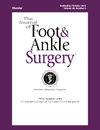关节镜解剖侧韧带重建后移植物成熟的MRI评估:一年随访研究。
IF 1.3
4区 医学
Q2 Medicine
引用次数: 0
摘要
本文章由计算机程序翻译,如有差异,请以英文原文为准。
MRI evaluation of graft maturation following arthroscopic anatomical lateral ligament reconstruction: a one-year follow-up study
Background
Chronic lateral ankle instability (CLAI) occurs in 20% to 40% of patients after lateral ankle sprains. Anatomical ligament reconstruction is increasingly used, but magnetic resonance imaging (MRI) evaluation of graft maturation—standard in anterior cruciate ligament (ACL) reconstruction—remains poorly defined for the ankle.
Purpose
To evaluate graft incorporation and ligamentization one year after arthroscopic anatomical reconstruction of the anterior talo-fibular ligament (ATFL) and calcaneo-fibular ligament (CFL) using autologous gracilis tendon grafts.
Study Design
Prospective case series.
Methods
We included 93 patients with CLAI unresponsive to conservative treatment who underwent ATFL/CFL reconstruction with an autologous gracilis graft. MRI was performed at one year postoperatively. Graft maturation was assessed using the Signal-to-Noise Quotient Ankle (SNQA) and the Howell scale. Graft incorporation was evaluated via signal intensity at the bone–graft interface. Additional analysis included graft continuity, tunnel positioning, and diameter.
Results
Howell grade was ≤2 in 42% of ATFL and 80% of CFL grafts. Mean SNQA was 39.25 ± 159.89 for ATFL and 17.44 ± 80.01 for CFL. Graft incorporation (interface signal grade 1 or 2) was seen in 74% of talar tunnels, 90% of calcaneal tunnels, and 87% of fibular tunnels. All grafts were continuous; no intra-articular complications were identified.
Conclusion
Anatomical reconstruction of the ATFL/CFL with gracilis autografts leads to good graft incorporation and ligamentization at one year. MRI parameters described here offer a reproducible evaluation framework, although correlation with functional outcomes remains necessary.
求助全文
通过发布文献求助,成功后即可免费获取论文全文。
去求助
来源期刊

Journal of Foot & Ankle Surgery
ORTHOPEDICS-SURGERY
CiteScore
2.30
自引率
7.70%
发文量
234
审稿时长
29.8 weeks
期刊介绍:
The Journal of Foot & Ankle Surgery is the leading source for original, clinically-focused articles on the surgical and medical management of the foot and ankle. Each bi-monthly, peer-reviewed issue addresses relevant topics to the profession, such as: adult reconstruction of the forefoot; adult reconstruction of the hindfoot and ankle; diabetes; medicine/rheumatology; pediatrics; research; sports medicine; trauma; and tumors.
 求助内容:
求助内容: 应助结果提醒方式:
应助结果提醒方式:


